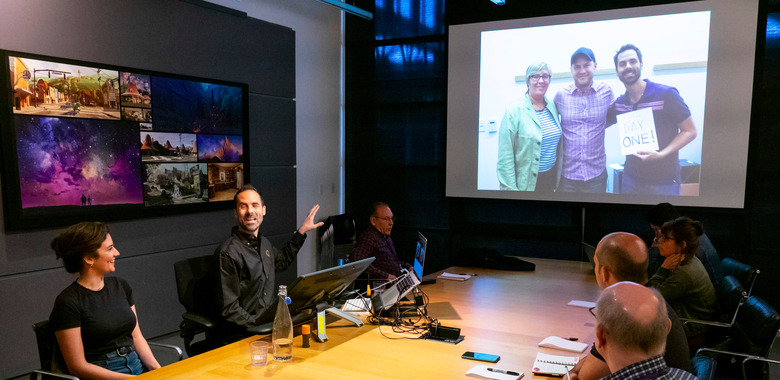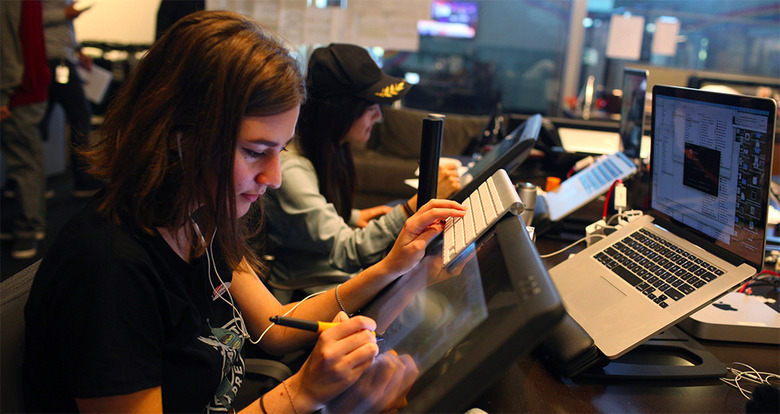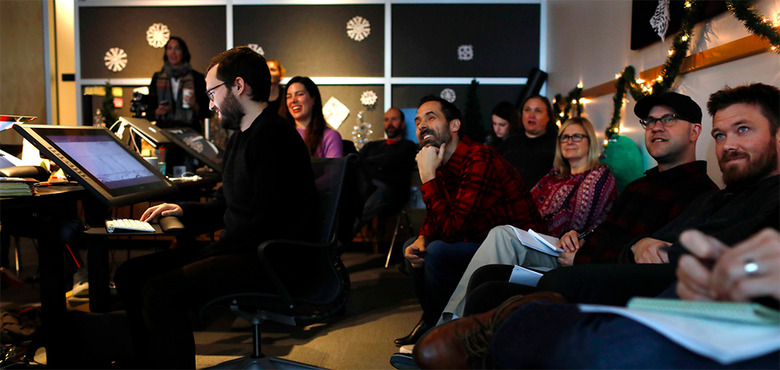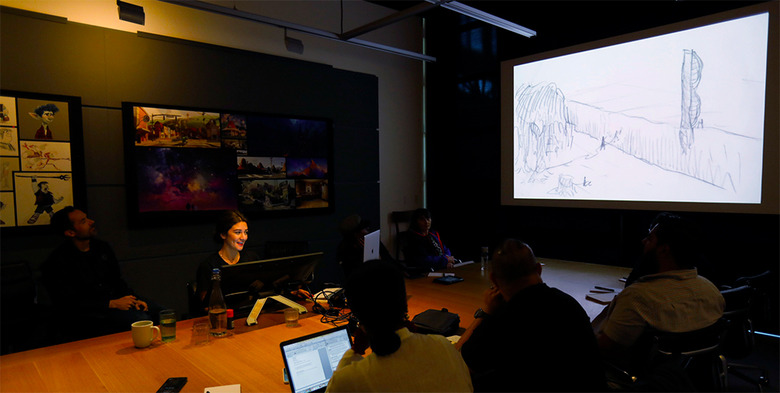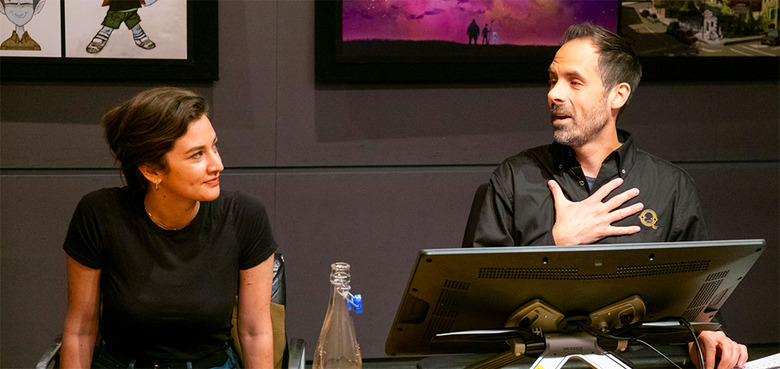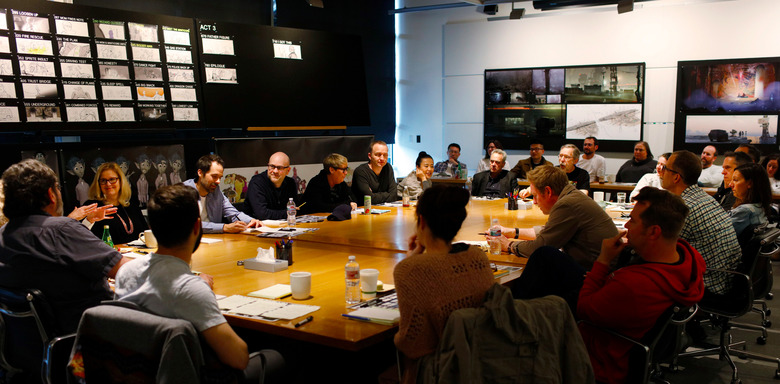Creating The Story Of 'Onward': Embarking On A Fantasy Adventure With Pixar Animation
This Spring brings the release of Pixar Animation's Onward, a modern fantasy adventure about Ian and Barley (Tom Holland and Chris Pratt) two teenage elf brothers who magically get the opportunity to spend just 24 hours with their late father, thanks to a magic spell, a wizard's staff, and a special stone. But when the spell to bring their father back for a day goes slightly wrong, they're quickly thrust into a race against time to find a bit more of the magic that used to make their world so special, all so they can get just a little more time with their dad.
Last Fall, /Film visited the campus of Pixar Animation of Emeryville, California to learn more about Onward, starting with how the story for this fantasy adventure first came together. As with all animated movies, the journey began years before, but this one stretched even further back, all the way to the Fall of 2013. And as with all stories, it started with a completely blank slate before becoming something touching, personal and magical.
First of all, if you haven't seen the latest trailer for Onward, here it is, along with the official synopsis:
Set in a suburban fantasy world, Disney and Pixar's "Onward" introduces two teenage elf brothers (voices of Chris Pratt and Tom Holland) who embark on an extraordinary quest to discover if there is still a little magic left out there.
Day 1 and Carding
Kelsey Mann (Head of Story) and Madeline Sharafian (Story Lead) introduced us to the story-building process that they utilized for Onward, which was a little different from how Pixar Animation usually goes through when writing and storyboarding.
Mann has been working on Onward since Day 1, which is not typical for a Pixar movie. Usually it's only the directors and producers that have been on since the beginning, but Mann worked hand in-hand with director Dan Scanlon and producer Kori Rae starting on September 17, 2013, as you can see in the photo above. Why did it take so long? That's just how careful Pixar is when it comes to getting the story just right.
The process began with what was referred to as carding, which is where the head of story works with the director to think up ideas for scenes that will combine to form the narrative. Each scene is represented by a notecard that is organized on a massive bulletin board as they try to figure out which scenes should go where, creating some semblance of a cohesive narrative.
The carding process is all about testing ideas, throwing out cards that don't work, adding new cards that might enhance the story, and rearranging the order of scenes. After some work, Scanlon and Mann were joined by a few more writers and story artists, but the process of creating the actual movie hadn't even begun yet. Pixar is very meticulous about getting the story to a place they're satisfied with before they even think about creating the art of the movie, and the story artists have a hand in that as part of the studio's signature collaborative process.
Once the carding was complete, a script was created, which then went through a rigorous process of getting notes from a small group of writers and story artists, each one coming with their own notes that help improve the script, adding a variety of perspectives in order to determine which beats in the script may not resonate as well as originally thought. Once these notes were discussed, director/writer Dan Scanlon and writer Jason Headley rewrote the script.
Assigning Scenes and Storyboarding
After the script was complete again, story artists were assigned scenes with some additional insight and description from director Dan Scanlon. That combined with a script page is all the artists get before they go off and start drawing storyboards for the scene on their own. And these scenes are doled out in a room referred to as "The Fish Bowl," seen above.
For example, a scene referred to as the "Trust Bridge" sequence was storyboarded by story lead Madeline Sharafian, but only after Scanlon read through the script with the group, complete with dialogue and little details he's envisioned in the scene.
The scene in question follows elf brothers Ian and Barley hitting a little hiccup in their quest when they reach a bottomless valley. Whatever falls into it keeps falling forever. There's a bridge to cross the valley, but the switch to drop it is on the other side of the chasm, which means Ian is going to have to try some magic to drop the bridge.
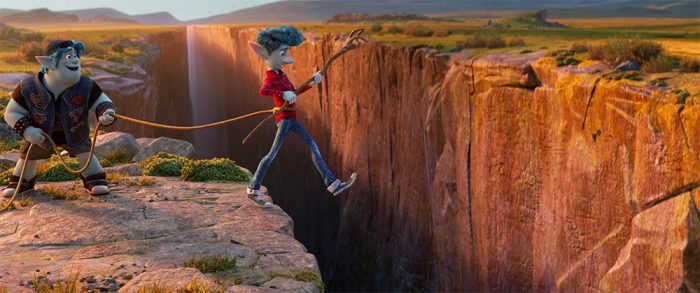
During the description of this scene from the script by Scanlon, Sharafian specifically remembered Scanlon mentioning some crumbling rocks falling off the edge of a cliff to illustrate the bottomless nature of the valley and made sure to include them somewhere in the scene. This process is done for every single scene in the movie.
Even though this is just the storyboarding part of production, these artists are still thinking ahead to all the details and layers still to come in the animation process, which includes cinematography, acting, characters, staging, editing, humor, design, composition, and that pesky deadline that ends up coming pretty fast. Here's how some of the storyboards on Onward looked (these come from the scene where Ian and Barley use magic to bring their father back, but only manage to get half his body).
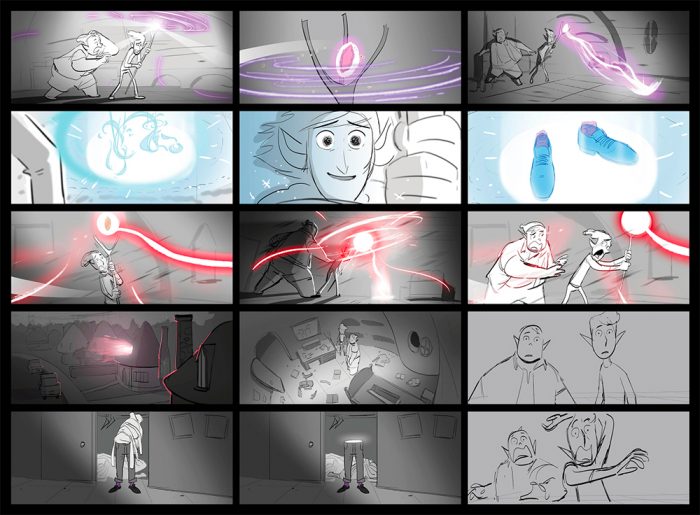
What's interesting about the story process on this film is that the story artists working on their respective scenes would often look over each others' shoulders, checking out the work of their colleagues, offering ideas to each other as they drew out their storyboards.
Mann and Sharafian made it clear that not all Pixar movies operate this way. This was essentially their version of being on set and creating the same energy there is when a whole crew is working together to make a movie, something that doesn't often happen in animation with everyone working at computers in their own offices most of the time.
The result ended up being the creation of 97,759 storyboards for this movie. That's a lot of storyboards, even if that work is spread out over years. But the story artists know how to take a break and blow off some steam from time-to-time, as evidenced by a video shown to us with the gang having a sing-along to "I'll Make a Man Out of You" from Mulan.
Pitching the Scenes
Once story artists completed storyboards for a given scene, they then had to pitch it for the rest of the story artists, the editing team, the art department, as well as director Dan Scanlon and producer Kori Rae.
Sharafian provided an example of what it's like to pitch a scene during these Fish Bowl meetings, and it involves software called Pitch Doctor, that is basically like Power Point for animators, which allows them to go through a scene storyboard-by-storyboard, including some animated accents that help bring the scene to life. But it also allow for quick edits during the notes process.
Each story artist runs through their scene, reading action, dialogue, and even sound effects, as if they were telling a story to a bunch of kids at the library. The importance of the collaborative nature of Pixar really shines through here, and it's clear why there are so many cooks in the kitchen for these movies. Each scene has a story to tell, and each story artist has to be a gifted storyteller in their own right to make it come to life.
Making Adjustments
In case you haven't realized it by now, what makes Pixar's collaborative story process so successful is the constant rewriting, revisioning, and reimagining. For example, after scenes were pitched for the first time, director Dan Scanlon offered his thoughts and notes for each scene storyboarded, and then he would ask for thoughts from the rest of the group, fostering a very open and collaborative environment where story is king.
Mann expressed his respect for the process as both a story artist and head of story, saying:
"I love that everybody is able to bring something to the film to elevate it. It's an interesting thing to be a story artist because you have to take the scene, and you have to be like, 'I'm owning this. It's becoming a part of me.' You put so much into it, and then you open it up to the room. You go, 'Okay, it's no longer mine.' We're making something collectively together, which is a film. So anytime someone gets too precious about their scene, it ends up being a problem. It's all about how can we take this thing and elevate it to something great."
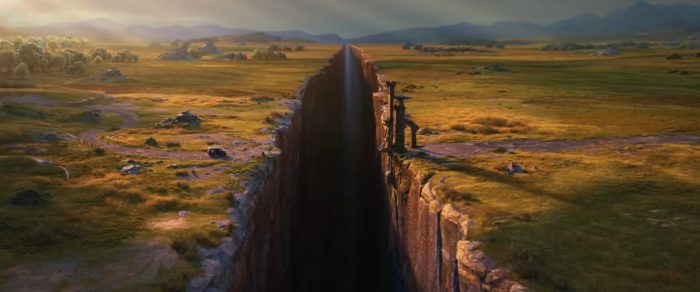
Going back to the trust bridge sequence mentioned above, Mann described one instance where this process improved the scene, and it involved adjusting the perspective of certain shots so that the audience always feels connected to our hero, Ian. So what was initially a distance drone-style shot introducing us to this bottomless valley that Ian and Barley stumbled upon, we get to experience the moment from a perspective that makes Ian more prominent in the scene, including giving us a shot from Ian's POV.
What's incredible about these changes is that they don't need an immense amount of time to complete. Mann created addition storyboards in a matter of seconds that fixed this problem thanks to the software used to pitch scenes and take notes. Obviously it's not always that easy, especially since this was a change that was undoubtedly made during the production process. But it just goes to show you how helpful these kind of collaborative meetings can be. If Pixar is this meticulous about a specific scene, you can imagine how they are when it comes to creating an entire feature film.
Recording Scratch
One of the more impressive feats when creating an animated movie, at least at Pixar Animation, is how much of the process is done before any of the actual dialogue from the film's voice cast is recorded. In fact, it's the story artists, writers and even director Dan Scanlon himself who participate in what is called "recording scratch." This is when the written lines are recorded and applied to storyboards in order to get a better idea of how a particular scene flows.
Even though the movie needs professional actors to bring these characters to life, these artists can do the characters enough justice to determine whether or not a scene is working. It's much easier (and cheaper) than bringing the likes of Tom Holland and Chris Pratt in to try every different version of a scene or variation of a line when the scene itself isn't even finalized for animation yet. Dan Scanlon himself voiced Ian during scratch, and Mann (seen above right) looked forward to being pulled out of his office to record some quick lines for scenes throughout the story process.
Sending Scenes to Editorial
Once a scene was completed, it got sent to the editorial department who takes all the storyboards with scratch dialogue, cuts them together as they would a scene, adds some sound effects, and then reviews it with the story artist to see if any changes need to be made.
Keep in mind that this process is done for every single scene, and often times, it's done multiple times for each scene until they have a very basic cut of the movie done. And this is all before any actual animation even takes place. That's what makes Pixar movies such finely tuned stories.
Even after a screening like this was complete, which happened every few months throughout the process of crafting the story, there were notes from the screening to continue the collaborative process during braintrust meetings (seen above). These notes came from people working on the movie and people working on Pixar's other projects who may have had no idea what Onward was even about because they're too wrapped up in their own production process.
These were essentially in-house test screenings with other storytelling professionals so the director, writers, and story artists are able to figure out what needs to be reconfigured in order to better tell the story. In case you haven't noticed by now, everything Pixar does is in service of the story, even if that means scrapping huge chunks of a movie that took months to complete.
***
As for whether or not all of this hard work will result in yet another home run for Pixar, that remains to be seen. The buzz on the movie doesn't seem quite as high as it should be at this point, but the movie is still roughly a couple months away from hitting theaters. Based on what we were shown at Pixar's campus, both in footage and in production presentations, this movie seems to be one of the most personal stories the animation studio has ever told, thanks to director Dan Scanlon's personal experiences. Hopefully that level of intimacy mixed with this fantastical world results in something magical on the big screen.
Onward arrives in theaters on March 6, 2020.

